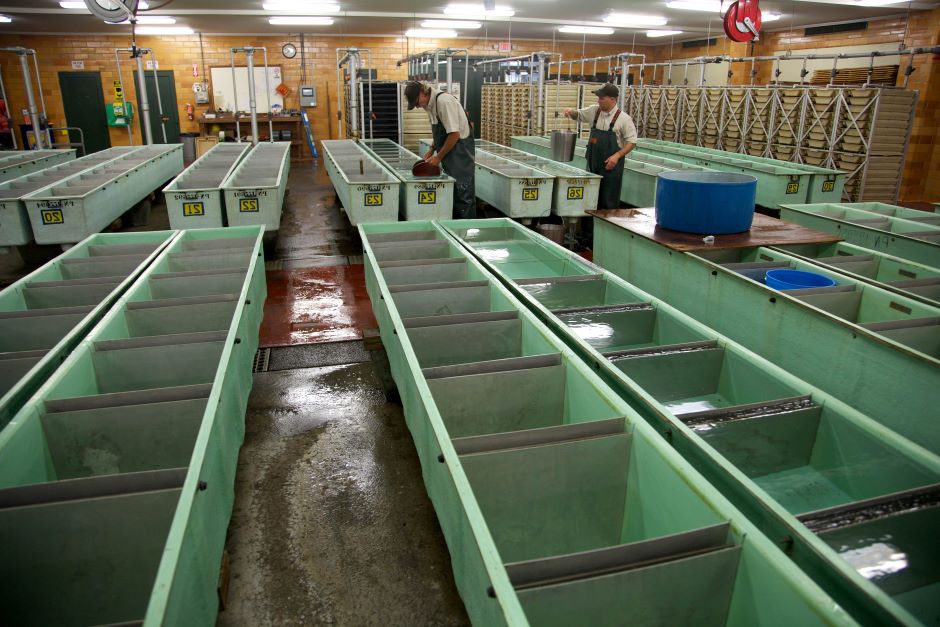Bacterial Coldwater Disease In Hatcheries
 Photo by Hagerty Ryan, USFWS on Pixnio
Photo by Hagerty Ryan, USFWS on PixnioBacterial Coldwater Disease threatens wild and hatchery-raised fish of all species, though its impact on salmonids in the past few years has been particularly notable. BCWD impacts salmonids at a higher rate than other wild or farmed species and has impacted the fishing industry and the economy. The disease spreads from fish to fish once introduced into wild or controlled habitats.
According to the Alaska Department of Fish and Game, “Transmission of BCWD is horizontal through the water column and vertically through the eggs of infected adult salmonids.” Bacterial Coldwater Disease is found in temperate regions that align with salmon spawning habitats and climate conditions worldwide. The ADFG suggests, “The bacteria is isolated from internal organs and gonadal fluid of returning adult salmon suggesting they are carriers of the infection during their seawater phase but reinfection upon entering freshwater is also possible.”
BCWD can be dormant in fish until activated by cold temperatures, wherein the fish develops the systemic disease in water below 12 degrees Celsius or 53 degrees Fahrenheit. The causative agent of BCWD, Flavobacterium psychrophilum, is a Gram-negative proteolytic bacterium meaning it regulates a large number of cellular processes leading to disease in fish that carry the activated bacteria, according to a study examining how the bacteria becomes active.
Fish infected with Bacterial Coldwater Disease show multiple clinical signs of exposure but are often only characterized by later stages of the illness. Necrosis that starts in the fins and spreads to the caudal peduncle, or where the tail meets the body, is common with more long-term infections. The ADFG describes that once the necrosis has spread enough, the fish’s invertebrate may become exposed as the tissue deteriorates.
One of the first clinical signs to look for is a darkening of the peduncle region when water temperatures are below 12 degrees Celsius. Once this darkening has begun, the ADFG reports a 50% mortality rate of fish before the occurrence of more erosion. Fish may also display an abnormal swimming posture from the destruction of muscle bundles near the spine or as a result of brainstem invasion.
Fortunately, if the disease is caught in its early stages, hatchery fish can be treated for infections with 1-hour treatments of formalin and BCWD antibiotic therapy. Treating the disease is vital to hatchery success as fish can spread the disease to each other and their spawn–an outbreak can threaten an entire hatchery population. Fortunately, hatchery conditions are controlled, allowing facility treatment, isolation, and identification. Wild salmon aren’t as lucky since identifying and treating the disease is unlikely to occur if the fish is always moving, unfortunately spreading the bacteria in the ecosystem.
Because of the better-controlled conditions, a Michigan University study found that salmon raised in hatcheries are less likely to contract BCWD from the beginning. Researchers worked over the course of five years to sample fish during spawning runs, as well as many that were living in state fish hatcheries. Fish that they considered in their analyses include lake, brook, brown and rainbow trout. They also sampled a variety of salmon: Coho, Atlantic, Chinook and steelhead. All of the fish were from different watersheds around Lake Huron, Lake Michigan and Lake Superior.
To ensure early recognition of infection, researchers used polymerase chain reaction confirmation, a type of DNA analysis, to check for the disease in fish. This helped show that BCWD was present in all stocks except captive lake trout and brook trout. Among the wild fish they considered, Chinook salmon from Lake Michigan had the highest prevalence of the disease. And of those fish held in captivity, the Gilchrist Creek brown trout strain had the highest infection prevalence.
The study confirms that BCWD is still a major concern for the Great Lakes and wild fisheries but can be combated through sound management practices and early recognition. The study also supports well-managed hatcheries as good sources for stocking fish that are free of disease. Fortunately, BCWD cannot be transmitted to humans; however, BCWD can impact adult fish populations, leaving fewer fish for consumption and destabilizing future fish populations with fewer adult fish during spawning season.


0 comments